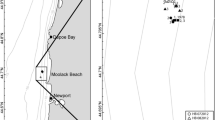Abstract.
We discuss methodological aspects directed to quantify the across-shore population structure and abundance of sandy beach macroinfauna. The reliability of estimates derived from design-based (stratified random sampling) and model-based (geostatistics, kriging) approaches is discussed. Our analysis also addresses potential biases arising from environmentally driven designs that consider a priori fixed strata for sampling macroinfauna, as opposed to species-driven sampling designs, in which the entire range of across-shore distribution is covered. Model-based approaches showed, spatially, highly autocorrelated and persistent structures in two intertidal populations of the Uruguayan coast: the isopod Excirolana armata and the yellow clam Mesodesma mactroides. Both populations presented zonation patterns that ranged from the base of the dunes to upper levels of the subtidal. The Gaussian model consistently explained the spatial distribution of species and population components (clam recruits and adults), with a minor contribution (≤5%) of unresolved, small-scale variability. The consistent structure of spatial dependence in annual data strongly suggests an across-shore-structured process covering close to 35 m. Kriging predictions through cross-validation corroborated the appropriateness of the models fitted through variographic analysis, and the derived abundance estimates were very similar (maximum difference=7%) to those obtained from linear interpolation. Monthly analysis of E. armata data showed marked variations in its zonation and an unstable spatial structure according to the Gaussian model. The clear spatial structure resulting from species-driven sampling was not observed when data was truncated to simulate an environmentally driven sampling design. In this case, the linear semivariogram indicated a spatial gradient, suggesting that sampling was not performed at the appropriate spatial scale. Further, the cross-validation procedure was not significant, and both density and total abundance were underestimated. We conclude that: (1) geostatistics provides useful additional information about population structure and aids in direct abundance estimation; thus we suggest it as a powerful tool for further applications in the study of sandy beach macroinfauna; and that (2) environmentally driven sampling strategies fail to provide conclusive results about population structure and abundance, and should be avoided in studies of sandy beach populations. This is especially true for microtidal beaches, where unpredictable swash strength precludes a priori stratification through environmental reference points. The need to use adaptive sampling designs and avoid snapshot sampling is also stressed. Methodological implications for the detection of macroecological patterns in sandy beach macroinfauna are also discussed.
Similar content being viewed by others
Author information
Authors and Affiliations
Additional information
Electronic Publication
Rights and permissions
About this article
Cite this article
Defeo, .O., Rueda, .M. Spatial structure, sampling design and abundance estimates in sandy beach macroinfauna: some warnings and new perspectives. Marine Biology 140, 1215–1225 (2002). https://doi.org/10.1007/s00227-002-0783-z
Received:
Accepted:
Issue Date:
DOI: https://doi.org/10.1007/s00227-002-0783-z




